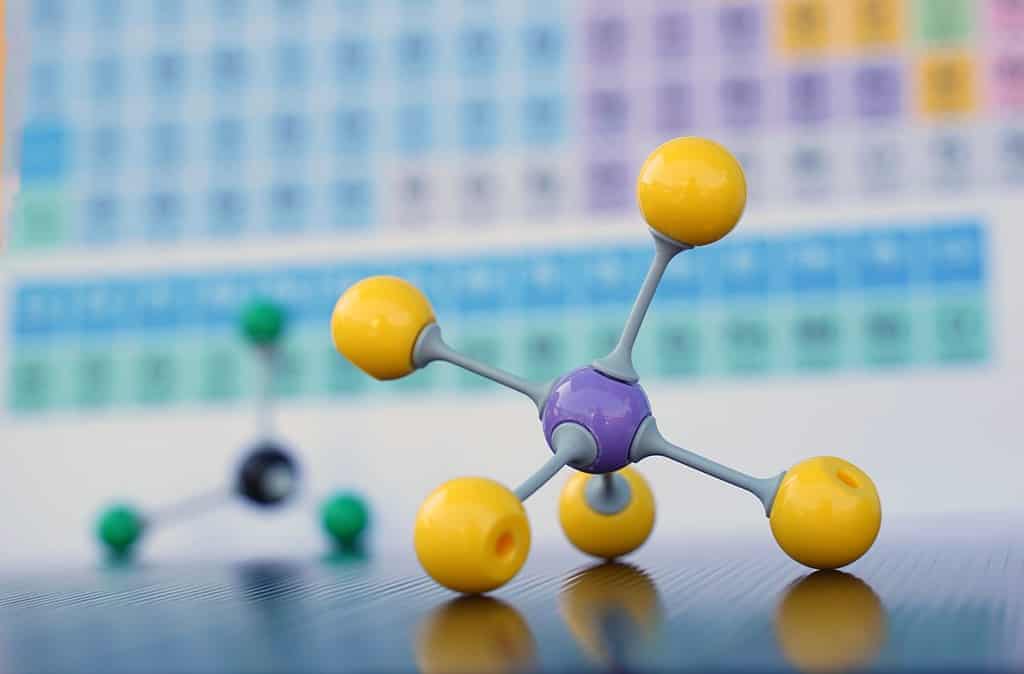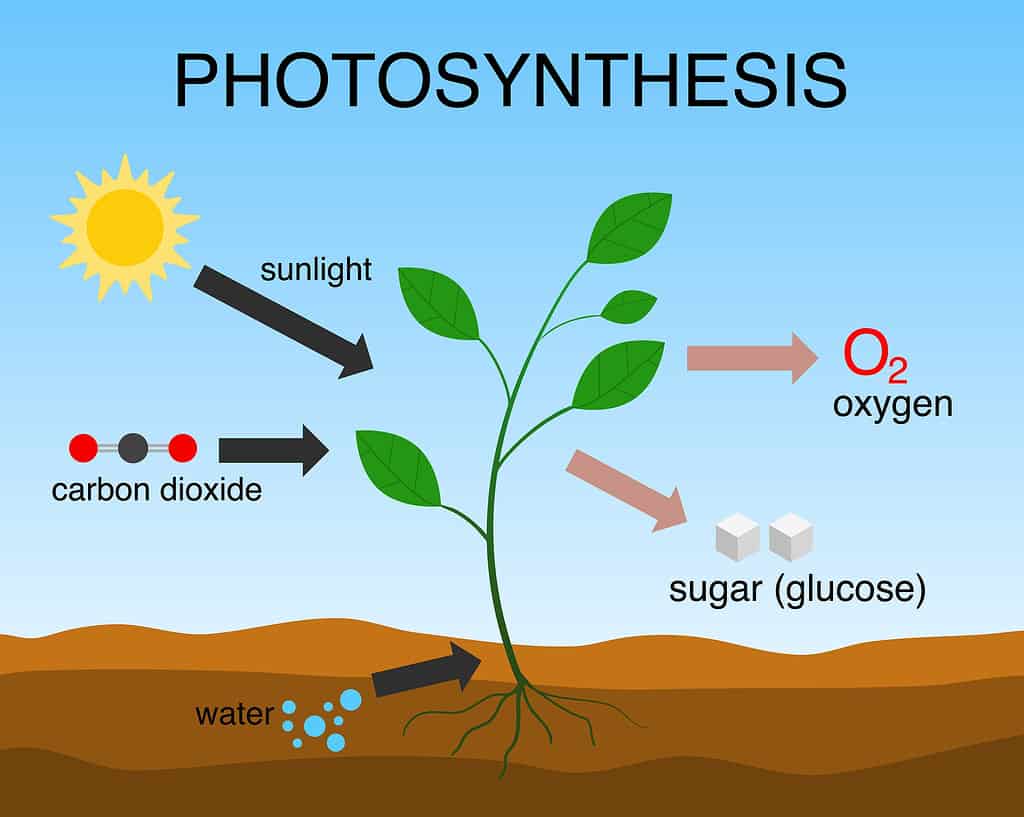Glucose is a sugar that gives us the energy to function every day. Think of it as the gasoline that powers our bodies. You can find it in many things we eat and drink, like corn or fruit juice. When we eat, our bodies break down the food into glucose and other nutrients, which are absorbed into our bloodstream, where they help us function and grow. Amazingly our brains use about half of the glucose energy in our bodies.
As a compound, glucose consists of six carbon atoms, 12 hydrogen atoms, and six oxygen atoms, all stuck together in a specific way, and we call this C6H12O6. Knowing the molar mass of glucose can come in handy in various ways. It can help with figuring out the right insulin dose for people with diabetes and how sweet a food or drink might be.
Read on to learn the molar mass of glucose and other key examples of this compound.
Defining Molar Mass

Molar mass is a way to measure the molecules of glucose.
©Aoy_Charin/Shutterstock.com
The molar mass of glucose is approximately 180.18 grams per mole. When scientists talk about the molar mass, they’re talking about how much a certain amount of stuff weighs. And it’s measured in something we call grams per mole, which is scientist-speak for the weight of a certain amount of stuff. That stuff could be anything — atoms, molecules, oranges, or even grains of sand. But in chemistry, we usually use it to count tiny things like atoms and molecules.
Even though atoms and molecules are too tiny to see or weigh individually, scientists can still calculate how much a mole of a certain substance weighs, and that gives them a way to measure and work with these tiny particles.
Think of it this way: when we say “a dozen eggs,” we’re talking about 12 eggs. When we say “a pair of shoes,” we mean 2 shoes. So, when scientists say “a mole,” they mean about 6.022 x 10^23 of something. And as you probably guessed, that’s a lot more than a dozen or a pair; 6.022 x 10^23 is a HUGE number.
When we talk about a mole of glucose, we’re talking about 6.022 x 10^23 glucose molecules. The number 6.022 x 10^23 is Avogadro’s number, named after the scientist Amedeo Avogadro. The number is so large because atoms and molecules are extremely small.
Why Molar Mass Matters

©Dabarti CGI/Shutterstock.com
Understanding the concept of a mole and molar mass is important in chemistry because it allows scientists to work with sensible amounts of substances. Even though atoms are too tiny to weigh, scientists can still calculate how much a mole of a certain substance weighs. The atoms’ weights are tiny, so scientists use a special unit called atomic mass unit (AMU). An amu is defined as one-twelfth the mass of a carbon-12 atom.
Just like a dozen eggs or a pair of shoes provides a way to talk about eggs and shoes, the mole quantifies substances on atomic and molecular levels. This lets scientists study and understand the behavior of matter with greater precision.
When you hear about a mole in the scientific context, remember that it represents an astonishingly large number of particles. And knowing the molar mass allows us to explore our world on a microscopic level.
Molar Mass in Everyday Life
As you journey further into the realm of molar mass, you’ll encounter its practical applications in various aspects of everyday life. For instance, molar mass plays a big role in determining medication dosages. It ensures that the correct amount is administered for optimal treatment. If we couldn’t measure molar mass, determining a patient’s insulin dosage would be nearly impossible.
Molar mass also helps in understanding the nutritional content of food. It enables us to make informed dietary choices. Beyond that, molar mass contributes to analyzing and monitoring the quality of our environment.
And it’s not just the molar mass of glucose that matters. Knowing the molar mass of other elements and compounds can also make the world a better place. Scientists can assess air quality and identify pollutants by quantifying the molar mass of gases in the atmosphere. Using this information, they can then devise strategies to protect our planet.
How to Calculate Molar Mass of Glucose
How do we calculate the molar mass of glucose? We take the weights of carbon, hydrogen, and oxygen atoms and add them all up, considering the number of each in a glucose molecule. And boom, we find that the molar mass of glucose is 180.18 grams per mole.
One mole of glucose contains 6.022 x 10^23 molecules of glucose. It’s a common unit in chemistry representing Avogadro’s number. If we talk about how much one mole of glucose weighs, it’s 180.18 g. And two moles? Just double that amount to get 360.36 grams.
Elements Found in Glucose
What are the elements in glucose? There’s Carbon (C), Hydrogen (H), and Oxygen (O).
First up, we have carbon (C), the main building block of all living things. Then, there’s hydrogen (H), the universe’s lightest and most abundant element. Oxygen (O) is also in the mix, which we need for our respiratory system. Oxygen allows us to breathe and keep our bodies running.
Glucose in Human Cells

Human cells rely on glucose for energy.
©Anusorn Nakdee/Shutterstock.com
Glucose acts as the powerhouse within our cells, breaking down to provide us with energy.
Many athletes consume glucose-rich foods before intense workouts or competitions because glucose is a quick and easy energy source. Glucose is also important in cell signaling, a communication system within our body’s cells.
Glucose is so essential that our bodies can make it from other things, like proteins and fats. This process is called gluconeogenesis. The body maintains a stable glucose level in the bloodstream to ensure that cells have a steady fuel supply. This is why we have hunger signals. The best part is that glucose can be stored in our bodies for later use. Stored glucose, or glycogen, is primarily found in the liver and muscles.
Glycolysis is not exclusive to humans; it’s essential for all mammals, birds, and even many insects. This process, where glucose breaks down to release energy, occurs in nearly every living organism.
Plants Use Glucose

Plants use glucose in many ways, including to produce chlorophyll, which helps them stand up strong.
©aiyoshi597/Shutterstock.com
Glucose plays a big role in the life of plants, serving as the primary source of energy for plant cells. During photosynthesis, plants use sunlight, carbon dioxide, and water to produce glucose as a byproduct. Once produced, glucose fuels the plant’s growth, repair, and metabolism.
Additionally, plants store excess glucose in the form of starch. Starch acts as a reservoir of energy that can be tapped into when needed, such as during periods of low sunlight or in parts of the plant that require energy for growth.
If plants didn’t produce glucose, they couldn’t stand up tall. Plants need glucose as the raw material to create cellulose. And cellulose is necessary to build cell walls. Strong cell walls support them to grow tall and stay upright.
Birds Use Glucose

Glucose helps birds fly long distances without running out of energy.
©Fercast/Shutterstock.com
Birds rely on glucose to fuel their high-energy activities, such as flying long distances or performing intricate aerial maneuvers. When a peregrine falcon dives at speeds of 200 mph, it’s because they have the energy necessary to make such a daring move.
When birds consume food, their bodies break down the nutrients, including carbohydrates, into glucose. This glucose goes directly to their flight muscles, rapidly converting into the energy needed to flap their wings and take to the skies.
Amazingly, birds can change how they store energy depending on the season and where they live. They store more glucose and glycogen in colder places and at higher elevations. Adapting to changing conditions and food availability helps them survive in different environments.
Bacterias Use Glucose

Bacteria rely on glucose for energy to reproduce, move, and nutrient uptake.
©iStock.com/Md Saiful Islam Khan
Even the tiniest creatures, like bacteria, rely on this simple sugar to power their microscopic world. Bacteria have a wide array of metabolic pathways, and glucose is a vital energy source for many bacterial species.
Just like we rely on glucose to power our bodies, bacteria break down glucose through a process called glycolysis, extracting energy along the way. Bacteria then use this energy to perform essential functions like reproduction, movement, and nutrient uptake.
Compounds With Similar Molar Mass
Let’s look at some compounds with a molar mass similar to glucose (C6H12O6), which has a molar mass of around 180.18 g/mol.
| Compound | Chemical Formula | Molar Mass (g/mol) | Description |
|---|---|---|---|
| Fructose | C6H12O6 | 180.16 | Found in table sugar |
| Galactose | C6H12O6 | 180.16 | Combines with glucose to form lactose |
| Mannose | C6H12O6 | 180.16 | Plays a role in human metabolism |
| Sucrose | C12H22O11 | 342.30 | A disaccharide (double sugar) made from glucose and fructose |
| Glucosamine | C6H13NO5 | 179.17 | Used for arthritis treatment |
| Ribose | C5H10O5 | 150.13 | Important for RNA and DNA structure |
| Sorbitol | C6H14O6 | 182.17 | Used as a sweetener, sugar alcohol. |
| Xylose | C5H10O5 | 150.13 | Found in corn cobs |
Sucrose has a much higher molar mass but still falls in a similar measurement category as glucose. That’s because we’re comparing glucose’s molar mass to larger molecules.
Final Thoughts on Molar Mass of Glucose
To wrap it up, the molar mass of glucose is about 180.18 grams per mole.
Knowing the molar mass of glucose is helpful in chemistry. It lets scientists calculate how much a mole of glucose weighs, which is useful for things like figuring out insulin doses or gauging how sweet foods or drinks are.
Glucose consists of carbon, hydrogen, and oxygen atoms and does many important things in our bodies. It helps release energy through a process called glycolysis, and it’s a byproduct of photosynthesis in plants. Athletes even munch on glucose-rich foods for a quick energy boost, and it plays a big role in cell signaling inside our body’s cells.
So, in a nutshell, glucose isn’t just some simple sugar. It’s a molecule that has a major impact on our lives. Understanding its molar mass and how it works helps us progress in medicine, food production, and more. Glucose isn’t just about energy; it plays a role in many important biological processes that keep living things going strong.
Thank you for reading! Have some feedback for us? Contact the AZ Animals editorial team.








